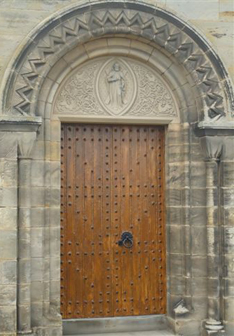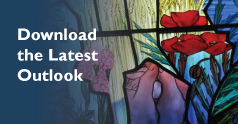
Gullane Parish Church History
The Church bears the name of the first man chosen by Jesus to be his disciple and Andrew stands carved in the arch of the South Door, looking out over East Lothian’s fields in all weathers and seasons. He looks towards Athelstaneford where, legend tells, in the eighth century our ancestors saw a white cross against a blue sky and took it as a sign that victory would be theirs that day despite the high odds against them. The Saltire was adopted as their special flag and a link forged between Andrew and East Lothian which, God willing, will never be broken. The Saltire is also to be seen over the same South Door.
The stone font to which our children are brought for Baptism is special too - the water stoop coming from the ruins of the old twelfth century Church of St. Andrew.
The Dawson Memorial windows each have significance to the church. The Celtic missionary in his rough habit typifies the missionary monks who came north over the Lammermuir Hills centuries ago to set up turf and wattle settlements in the coastal area sheltered by these hills.
St. Margaret’s window in the centre, glowing with colour when the sun shines through, depicts the good Queen who made it her concern to build Parish Churches throughout Scotland. St. Margaret’s Chapel, still in use today, stands proudly on Edinburgh Castle rock.
The Soldier’s window is the memorial to all who have fought and died in the cause of freedom. In the Declaration of Arbroath in 1320 our forebears said – “It is not for honour or glory that we fight - it is for freedom, which no good man surrenders but with his life.” For if freedom goes, all goes, in our modern world as surely as in time gone past.
The Murray Memorial Window was created in 2003. Comprising three separate windows the artist, John K Clark, has treated them as one overall concept and has created an atmospheric, spiritual and poetic work, which captures the essence of the village and its beautiful surroundings. The Centre Window incorporates the sky and the sea, the sun and moon and stars, a flight of geese and gulls; the Right Hand Window comprises a local view of the sea from the dunes, fish in the water, buckthorn on the dunes, and oyster catchers flying through; and the Left Hand Window has oak, willow, apple, brambles, local orchids, poppies, violets, primroses, barley, a lark, sheep grazing, a dove symbolizing the holy spirit, and hands praying representing humanity. Each section can stand alone but they enhance each other as a group and the symbolism of local creation is a powerful reminder of God’s presence.
Look closely at our pulpit when you get the chance. Note well the little dog carved near the base. It has formed the basis of more than one sermon - Matthew 15, verse 27:-
“And she said, Truth, Lord: yet the dogs eat of the crumbs which fall from their master’s table.”
The story is of the Canaanite woman whose faith was rewarded when her daughter was made whole. The eyes of the little dog carved on our pulpit are fixed on the preacher every Sunday ready to catch every crumb which might fall. Christ was careful to use the Jewish word for dog which was a household pet who nestled at his master’s feet and was given the best tit-bits from the table. The story has many nuances but all are significant of the whole story of Jesus Christ.
In 2013 we celebrate the 125th Anniversary of the opening of the present church. Throughout that time successive generations have worshiped there, and we pray that that will continue to be the case for all time.
The Bible has many passages which contain a message indicating that the Church has stood the test of time and which offer hope for the future and many hymns composed by great writers contain similar thoughts, but perhaps the best is the closing verse of one of the best known psalms, now number sixty three in the new hymnary but forever beloved as “The Auld Hundredth”-
For why? the Lord our God is good,
his mercy is forever sure;
his truth at all times firmly stood,
and shall from age to age endure
The epilogue to “Gullane Parish Church 1888 – 1988, A Centenary History”, published jointly by Gullane Local History Society and Gullane Parish Church in 1988, contributed by Maurice Timson (as amended to reflect the present day).
GULLANE PARISH CHURCH ACCOUNTS


